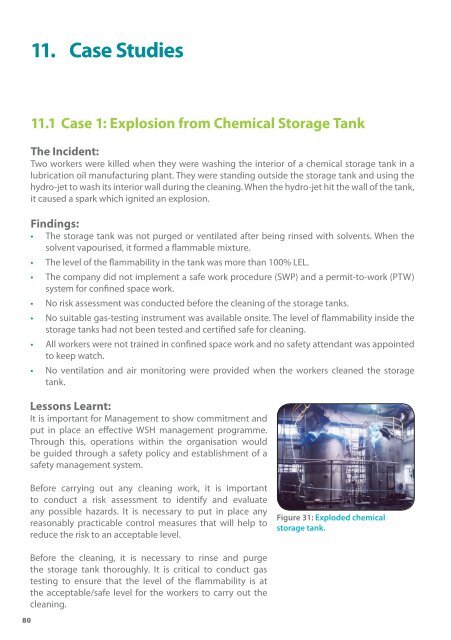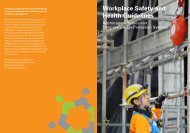Confined Spaces - Workplace Safety and Health Council
Confined Spaces - Workplace Safety and Health Council
Confined Spaces - Workplace Safety and Health Council
- No tags were found...
Create successful ePaper yourself
Turn your PDF publications into a flip-book with our unique Google optimized e-Paper software.
11. Case StudiesIt is also important to appoint a safety attendant to keep watch <strong>and</strong> continuously monitor theatmosphere so that it is maintained at acceptable/safe levels.11.1 Case 1: Explosion from Chemical Storage TankThe Incident:Two workers were killed when they were washing the interior of a chemical storage tank in alubrication oil manufacturing plant. They were st<strong>and</strong>ing outside the storage tank <strong>and</strong> using thehydro-jet to wash its interior wall during the cleaning. When the hydro-jet hit the wall of the tank,it caused a spark which ignited an explosion.Findings:• The storage tank was not purged or ventilated after being rinsed with solvents. When thesolvent vapourised, it formed a flammable mixture.• The level of the flammability in the tank was more than 100% LEL.• The company did not implement a safe work procedure (SWP) <strong>and</strong> a permit-to-work (PTW)system for confined space work.• No risk assessment was conducted before the cleaning of the storage tanks.• No suitable gas-testing instrument was available onsite. The level of flammability inside thestorage tanks had not been tested <strong>and</strong> certified safe for cleaning.• All workers were not trained in confined space work <strong>and</strong> no safety attendant was appointedto keep watch.• No ventilation <strong>and</strong> air monitoring were provided when the workers cleaned the storagetank.Lessons Learnt:It is important for Management to show commitment <strong>and</strong>put in place an effective WSH management programme.Through this, operations within the organisation wouldbe guided through a safety policy <strong>and</strong> establishment of asafety management system.Before carrying out any cleaning work, it is importantto conduct a risk assessment to identify <strong>and</strong> evaluateany possible hazards. It is necessary to put in place anyreasonably practicable control measures that will help toreduce the risk to an acceptable level.Before the cleaning, it is necessary to rinse <strong>and</strong> purgethe storage tank thoroughly. It is critical to conduct gastesting to ensure that the level of the flammability is atthe acceptable/safe level for the workers to carry out thecleaning.Figure 31: Exploded chemicalstorage tank.In addition, it is essential to establish safe work procedures <strong>and</strong> implement them to ensure thatstorage tank cleaning can be carried out safely without endangering the safety of the workers<strong>and</strong> other workers in the vicinity.11.2 Case 2: Exposure to Phosgene Gas during Gas TestingThe Incident:Some pipelines of a chemical plant were contaminated with toxic gases due to process deviation.These areas needed to be isolated <strong>and</strong> purged to ensure that they were free of toxic gases.After the purging, an engineer was tasked to perform a gas test with a portable phosgenedetector at a valve outlet before h<strong>and</strong>ing over to the Maintenance Section. While he was openingthe manual valve slowly, suddenly, some phosgene vapours escaped from the valve causing himto inhale the toxic gas.The injured engineer was subsequently pulled away by a technician <strong>and</strong> two sub-contractorswho were with him to witness the test.Findings:• An isolation valve at the upstream which was connected to the buffer tank was not fullyclosed. This had caused the vapour to leak from the tank into the pipelines.• The potential hazard of the workers exposed to the toxic gases during testing of isolatedpipelines for toxic gases was not fully addressed by the safe work procedures (SWP).• All workers were not trained in confined space work <strong>and</strong> no safety attendant was appointedto keep watch.• No risk assessment was conducted before the engineer carried out the gas testing.• No one was wearing any breathing apparatus during gas testing although a set of SCBA wasplaced on st<strong>and</strong>by outside the room.• No ventilation <strong>and</strong> air monitoring were provided when the engineer conducted the gastesting.Lessons Learnt:It is important for Management to show commitment <strong>and</strong> put in place an effective WSHmanagement programme. Through this, operations within the organisation would be guidedthrough a safety policy <strong>and</strong> establishment of a safety management system <strong>and</strong> proper workprocedures.Before carrying out any gas testing, it is important to conduct risk assessment to identify <strong>and</strong>evaluate any possible hazards. It is necessary to put in place any reasonably practicable controlmeasures that will help to reduce the risk to an acceptable level.It is critical for all individuals who carry out gas testing to be properly trained <strong>and</strong> fully instructedon the potential hazards in connection with the work. It is also necessary for them to put onappropriate protective equipment during the gas testing.80 81
















